Intel Core i7-5960X Extreme Edition, Core i7-5930K and Core i7-5820K Processors Review

Some times ago Intel has announced the new generation CPUs for high performance and high sophisticated PCs. This is Haswell-E. Thanks to it a performance-hungry enthusiasts get the new processor microarchitecture, DDR4 support and eight cores in one chip. Also the platform and processor socket are changing. We take a look at all these essential transformations.
Core i7 Extreme processors aren’t very popular judging by their sale volumes but their market positioning is pinpoint accurate. They are targeted at desktop users who want to have the best possible PC configuration. The Core i7 Extreme is the most desired option for enthusiasts who are into liquid-cooling solutions and multi-GPU subsystems. Yes, it is very expensive, yet it does let you build a maximum-performance and feature-rich platform. That’s why the Core i7 Extreme series keeps on developing.
Moreover, it looks like top-performance premium-class desktop PCs are not affected by the declining demand trend which dominates the PC market in general. Such computers still sell well, making Intel change its attitude towards them. The company’s top managers have promised to bring enthusiast-level CPUs back into their list of priorities.
The first step in this direction was made this summer with the release of the Devil’s Canyon series for high-performance overclockable computers. Based on the modern Haswell design, they come with clock rates above 4 GHz, which ensures a substantial performance boost. However, they cannot be regarded as the perfect option for uncompromising enthusiasts who own LGA2011 computers with six-core CPUs, quad-channel memory subsystems, lots of PCI Express lanes, etc. You don’t get any of that with the Devil’s Canyon series but, fortunately for enthusiasts, Intel has got a special solution for them.
We mean the Haswell-E CPU series, the LGA2011-v3 platform and the X99 chipset. Together, they provide everything a hardcore computer enthusiast might ever wish: multi-core CPUs with lots of cache memory, high-speed DDR4 SDRAM, and mainboards with an exhaustive selection of interfaces. Moreover, the Haswell-E is the only up-to-date CPU which has indium-based solder between the cap and the die. Being much more efficient than conventional thermal interfaces, it provides great overclocking benefits.
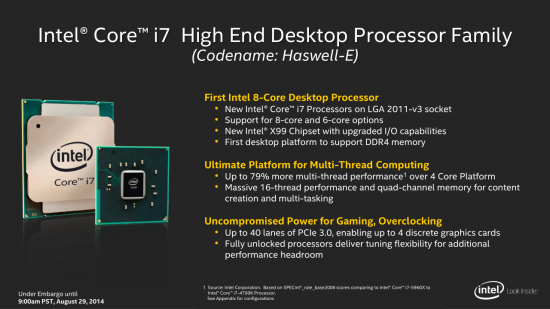
The new platform was officially announced on August 29, but we’ve waited a little for all of its components to become widely available. So today we can check out all existing LGA2011-v3 processors: Core i7-5960X Extreme Edition, Core i7-5930K and Core i7-5820K.
New Processors
Compared to the previous generation, Ivy Bridge-E, the new products of the Haswell-E series bring improvements in nearly each and every field with, perhaps, but one exception. They are manufactured on the same 22nm tech process with 3D transistors as their predecessors. Intel has already begun mass shipments of 14nm chips for tablets and slim notebooks, but the Haswell-E series is unified with server products which are not prone to be the first to feature new manufacturing technologies.
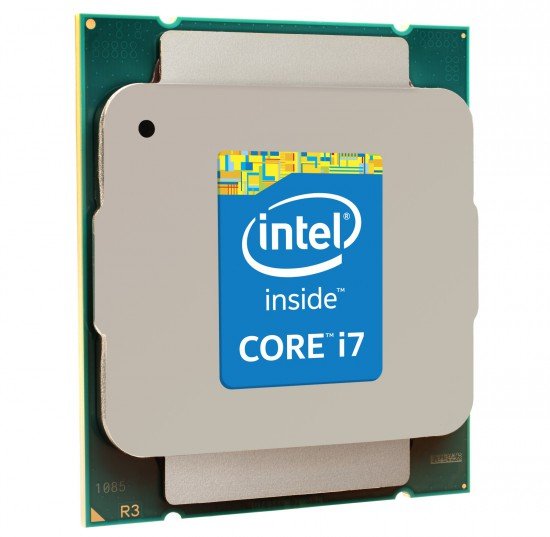
The key innovation is highlighted in the new series’ name: it is based on the Haswell design. Compared to the Ivy Bridge design, it is 5 to 10% faster (at the same clock rate) and supports the AVX2 instruction set for parallel data processing. With a voltage regulator built right into the CPU die, the Haswell design also allows for more accurate and energy-efficient power management.
Since the new Haswell-E processors are targeted at a rather small group of computer enthusiasts, we don’t have lots of models in the series. Like the earlier Sandy Bridge-E and Ivy Bridge-E series, it is comprised of only three models.
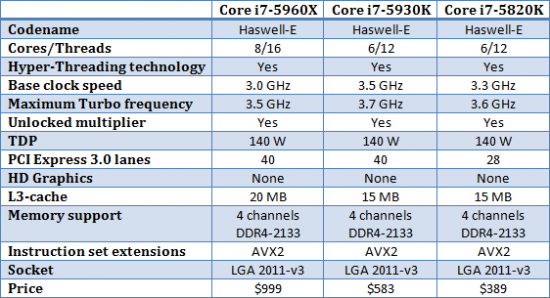
There are, however, differences in what these three models are. The flagship Core i7-5960X is a true 8-core processor with a 20MB L3 cache. Intel has never produced such desktop products before. Supporting Hyper-Threading, the processor can execute up to 16 threads concurrently. Its base clock rate is set at 3.0 GHz and its integrated PCI Express 3.0 controller provides 40 PCIe lanes. Like earlier Extreme Edition models, it is priced at $1000, but its clock rate doesn’t seem to be high. Well, the two additional cores increase its heat dissipation, so the clock rate has to be reduced in order to meet the TDP requirements. The Turbo Boost feature makes up for that somewhat as it can increase the clock rate of the Core i7-5960X by up to 3.5 GHz at low and medium loads.
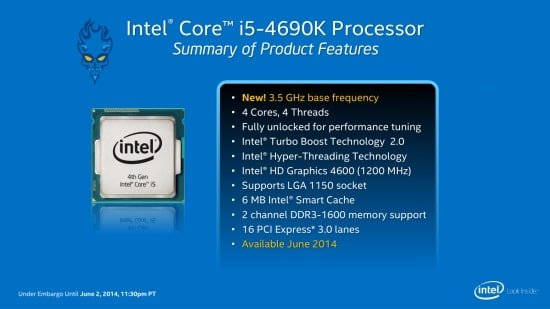
Unlike their predecessors, the new K series processors for the LGA1150 platform support the vPro and TXT security technologies, the VT-d virtualization, and TSX-NI instructions, which makes them interesting for corporate users. The TSX-NI instruction set is not yet implemented due to a recently discovered bug. It will be disabled on the firmware level with BIOS updates. Ordinary users are unlikely to feel any discomfort, though. TSX-NI is necessary to implement a transaction memory model in multithreaded environments which may only be required for specialized applications typical of multiprocessor servers.
Now let’s compare the Devil’s Canyon processors with their predecessors in terms of specifications.
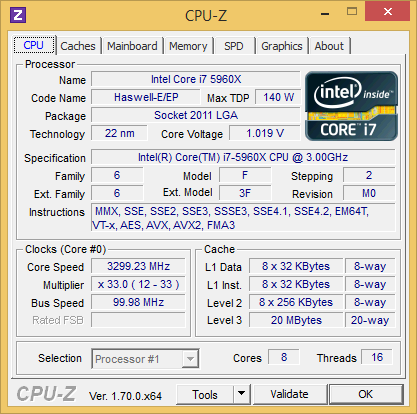
The Core i7-5960X is head above the previous flagship Core i7-4960X, the latter being comparable to the new midrange model Core i7-5930K. Like the i7-4960X, the i7-5930K has six x86 cores and a 15MB L3 cache, and supports 40 PCIe lanes. The new model has a lower clock rate, but the Haswell microarchitecture and the quad-channel DDR4 SDRAM controller should make up for that difference. The midrange Haswell-E costs about $600.
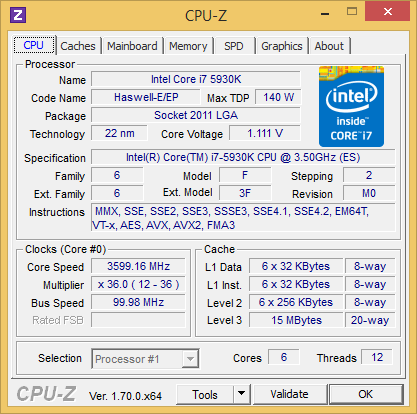
It is the junior model, Core i7-5820K, which seems to be the most interesting in the new series. With six cores, a 15MB L3 cache and a quad-channel DDR4 SDRAM controller, it only has 28 PCIe 3.0 lanes. This doesn’t seem right because it is only with LGA1150 platforms that we used to have a PCIe controller incapable of supporting two full-speed PCIe x16 slots. But we can put up with that deficiency because the rest of the specs are very good. The junior models of the Ivy Bridge-E and Sandy Bridge-E series, Core i7-4820K and Core i7-3820, were quad-core processors, but now we are offered a 6-core one for the same money ($400). The lack of support for x16/x16 graphics configurations is no big deal, especially as SLI and CrossFireX setups are not really limited by the interface bandwidth even when using PCIe x16 slots at x8/x8 speed. We know that by LGA1150 platforms. And unlike LGA1150 processors, the Core i7-5820K allows building a 3-component graphics subsystem with a speed formula of x8/x8/x8. The only significant difference of the junior model from its senior cousins is that it doesn’t support SLI configurations with four graphics cards but that hardly concerns many users.
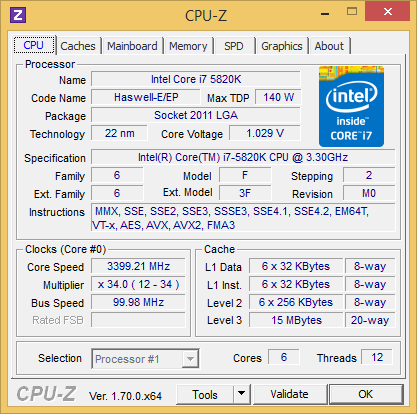
The semiconductor die employed in the Haswell-E series is similar to the Sandy Bridge-E and Ivy Bridge-E in its layout. There’s a 20MB L3 cache in the center. It is surrounded by eight x86 cores, a DDR4 SDRAM controller and an Uncore unit, all combined into a single whole by a ring bus.
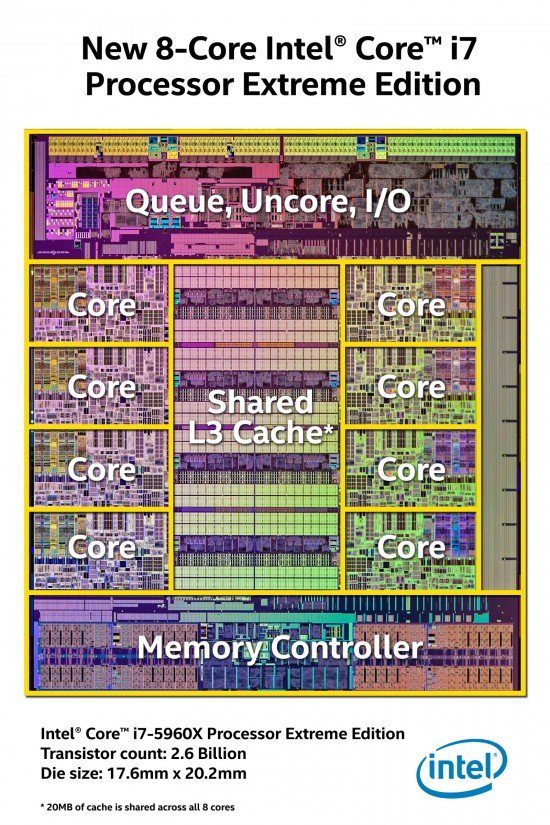
This 8-core die is used in all Haswell-E models but two x86 cores are disabled in the i7-5930K and i7-5820K. In fact, the 6-core models are made out of defective 8-core chips because any two opposite cores may be turned off. The section of the cache memory in between is disabled as well. That’s why the Core i7-5930K and Core i7-5820K have a smaller L3 cache than the Core i7-5960X.
A full Haswell-E die is 356 sq. mm large, incorporating 2.6 billion transistors. You can compare this with regular quad-core Haswell-based processors which have a 177 sq.mm die consisting of 1.4 billion transistors. The Haswell-E doesn’t set a new size record for desktop CPUs, though. It is larger than AMD’s 8-core Vishera, yet the 6-core Sandy Bridge-E have an even larger die (435 sq. mm). Compared to the previous flagship Ivy Bridge-E processor, the Haswell-E is larger by 39% and has 40% transistors more, their manufacturing process being the same (22 nm). The increase in transistor budget accounts for the 33% increase in x86 cores and the more sophisticated memory controller which now supports DDR4 SDRAM.
The newer CPU design and the integrated voltage regulator make the Haswell-E consume more power than their Ivy Bridge-E predecessors: 140 vs. 130 watts. That’s not a serious difference, though. Nearly all older coolers for LGA2011 CPUs are compatible with Haswell-E models. Moreover, Intel recommends the same cooler for them (a closed-circuit liquid cooling system TS13X with a 120x120x25mm radiator).
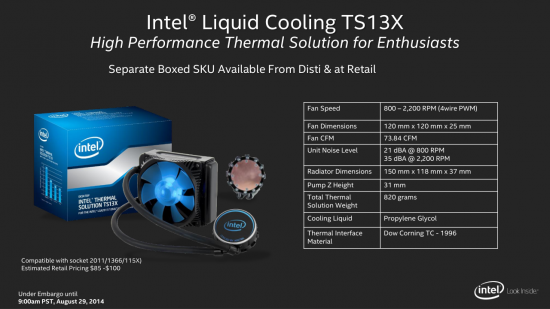
Take note, however, that the heat dissipation of the Haswell-E increases rapidly as soon as you overclock it – up to 200 watts in our tests!
New Platform
Besides the new Haswell design and DDR4 SDRAM, the LGA2011-v3 platform features the new Intel X99 chipset (codenamed Wellsburg). Replacing the outdated X79, it brings a full set of modern interfaces into Intel’s top-end platform. The X99 surpasses the recently released Z97 chipset for LGA1150 processors in terms of functionality.
We’ll discuss X99-based mainboards in our upcoming reviews, so today we’ll just briefly describe the chipset. Here’s its diagram:
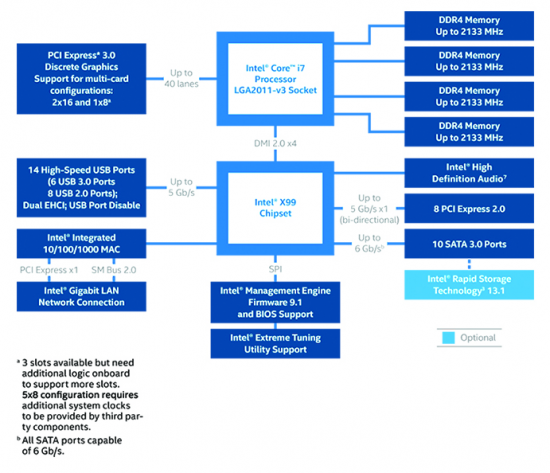
The diagram is correct for the CPU models with 40 PCIe 3.0 lanes which support PCIe x16 slots with a speed formula of 16x/16x/8x or 8x/8x/8x/8x/8x (the mainboard needs an additional clock generator for the latter). The Core i7-5820K has 28 PCIe 3.0 lanes, so it will supports speed formulas of 16x/8x/4x or 8x/8x/8x. The specific implementation will vary on different mainboards, so if you’re planning to build a multi-GPU configuration, you should check out beforehand how your mainboard distributes PCIe lanes among its slots.
The LGA2011-v3 platform uses DDR4 SDRAM. According to the specs, the top memory clock rate supported by the new CPUs is 2133 MHz. But in practice Haswell-E CPUs can clock memory at up to DDR4-2666 in their default mode and up to DDR4-3200 when overclocked. DDR4 SDRAM not only features higher bandwidth but also allows building large-capacity memory subsystems. Most LGA2011-v3 mainboards for desktop computers have two DIMM slots for each of the four memory channels and can work with up to 64 gigabytes of system memory. In the near future, unbuffered DDR4 modules with capacities of 16 GB are going to arrive, so the maximum amount of memory supported by Haswell-E based computers will go up to 128 gigabytes.
The Intel X99 has 10 SATA 6 Gbit/s ports via two independent controllers. Only one controller lets you build RAID arrays, so you can unite up to six drives into a RAID, just as with the previous chipset. The X99 also features the Flex I/O technology for combining SATA ports and chipset-based PCIe lanes into M.2 and SATA Express interfaces, so these two interfaces are fully supported.
A high-speed USB controller is implemented in the X99, so six out of the chipset’s 14 USB ports can work as USB 3.0 with a peak bandwidth of 5 Gbps.
We can note one weak spot in the X99 design. The DMI 2.0 bus which connects the chipset and the processor still uses four PCI Express 2.0 lanes. Its bandwidth of 20 Gbps in each direction may turn out to be insufficient for all the numerous high-speed interfaces implemented in the chipset.
That’s why the fastest interfaces are supposed to be implemented with CPU-based PCIe lanes on the new platform. Talking about the X99, Intel promises that there will be X99-based mainboards with the Thunderbolt 2 interface featuring a peak bandwidth up to 20 Gbps. Four times the bandwidth of USB 3.0, it can only be implemented using high-speed CPU-based PCI Express 3.0 lanes. Some mainboard makers implement the M.2 interface in the same way.
The LGA2011-v3 socket you can find on X99-based mainboards is much alike to Socket LGA2011 but there’s no electrical or mechanical compatibility between the older Ivy Bridge-E and the newer Haswell-E processors. You cannot put a wrong CPU in. The socket’s fastening levers have changed somewhat, too.
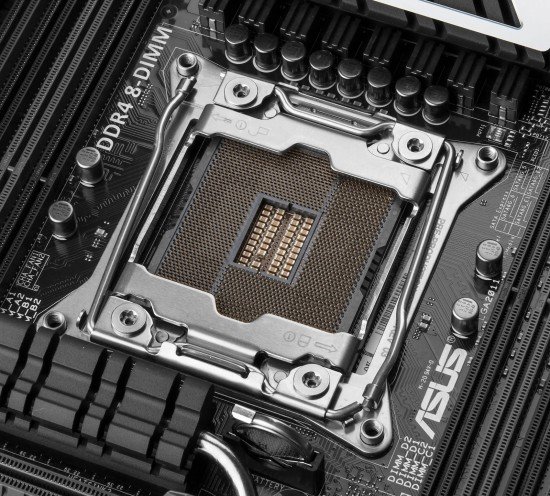
Mainboard makers have prepared a lot of X99-based LGA2011-v3 products, some of which are in the micro-ATX form-factor. They are priced at $210 to over $500. The least expensive offers come from ASRock and MSI (e.g. ASRock X99 Extreme3 and MSI X99S SLI Plus) whereas ASUS ships the most expensive ones (ASUS X99-E WS and ASUS Rampage V Extreme).
The overclocking results are poor because you can only change the voltage in a very narrow range. The best we could achieve with our i5-4690K – 4.4 GHz – is no better than the typical results of the i5-4670K released over a year ago. It also equals the specified clock rate of the i7-4790K in Turbo mode.
New Memory
Haswell-E series processors can only work with DDR4 SDRAM. It means the DIMM slots on LGA2011-v3 mainboards have 48 more contacts and a differently located key. DDR3 SDRAM is not an option with the Haswell-E. DDR4 modules are visually similar to DDR3 modules except that the middle contacts are longer than the outermost ones to make it easier to plug them into slots.
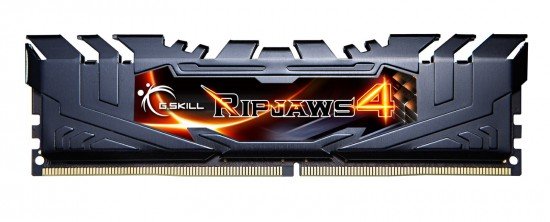
DDR4 SDRAM has a revised internal design to make it more appropriate for high-speed multi-core CPUs. A typical 8-gigabit DDR4 SDRAM device with a 4-bit interface consists of four groups of four banks each. Inside each bank there are 217 (131072) rows, each 512 bytes long. A same-capacity DDR3 device consists of only eight banks with 216 (65536) rows, each 2 KB long. Thus, DDR4 devices have more banks but smaller rows, which helps execute incoming requests in parallel.
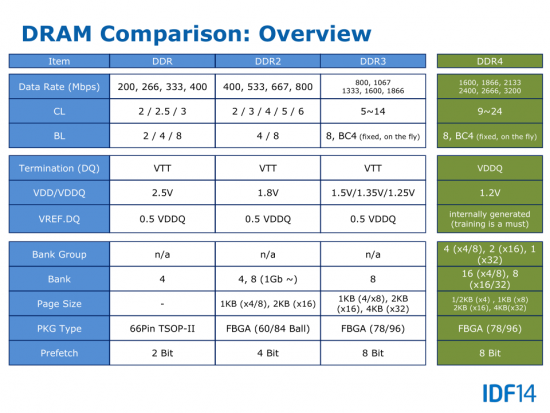
It is the faster parallel execution on the bank level that enables DDR4 SDRAM to work at high clock rates. As a matter of fact, any SDRAM, including DDR4, uses an internal clock rate of 100 to 266 MHz, and this clock rate has remained the same since the previous century. The higher clock rate of the external interface, which can vary from 2133 to (in a long-term perspective) 4266 MHz, is achieved by multiplexing data requests to different memory banks. Coupled with the 8x data prefetch introduced in DDR3 SDRAM, each outside access to DDR4 SDRAM generates 16 internal parallel data transfers. That’s why DDR4 SDRAM can theoretically have twice the clock rate of DDR3 SDRAM, although with higher latencies.
Currently, Haswell-E processors officially support DDR4-2133 with timings of 15-15-15 as specified by the JEDEC standard. And this seems to be worse than the speed offered by modern DDR3 SDRAM. Intel has never been pedantic in implementing memory standards, though. Haswell-E processors have unlocked multipliers, also for the memory controller, and there are faster memory modules available, up to DDR4-3200 CL16. You should only keep it in mind that the top guaranteed DDR4 frequency is limited to 2666 MHz unless you overclock your CPU. Higher clock rates are only possible if you change the base clock rate from the default 100 MHz to 125 MHz.
Thus, the single key advantage of DDR4 SDRAM so far is its low heat dissipation. It typically works at a voltage of 1.2 volts whereas overclocker-friendly modules may be designed for 1.35 volts. The new memory is 30-40% more energy efficient than DDR3 SDRAM.
Haswell-E Overclocking
There are usually some overclocking-related innovations in each new Intel platform. After the company had taken to catering to the overclocking community, we got a lot of interesting overclocking features over the past few years. But the developer’s creativity seems to have dried out, because the Haswell-E and the LGA2011-v3 platform have the same overclocking capabilities as the LGA1150. We have no problem with that, though. Unlocked Haswell-based CPUs can be overclocked quickly and easily.
The only obstacle to reaching high clock rates with them is the low-efficiency thermal interface between the processor’s cap and die but the Haswell-E connects the heat-spreading cap and the die with fluxless soldering using indium-based solder which features very high thermal conductivity. Thus, Haswell-E CPUs are going to be a real treat for enthusiasts who have got fed up with the overheat issues of regular Haswell-based products.
Theoretically, overclocking a Core i7-5960X, Core i7-5930K or Core i7-5820K goes like this. Each of these CPUs has fully unlocked frequency multipliers and lets you adjust their Turbo Boost settings. The maximum multiplier value has been increased since the Ivy Bridge-E and equals 80x.
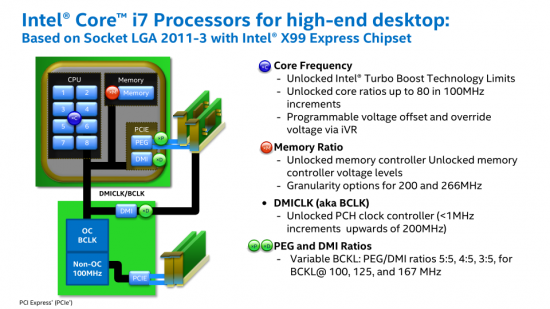
The CPU-integrated voltage regulator supports flexible voltage adjustment for the processor’s x86 cores and other subunits. All popular voltage adjustment methods can be used: static, offset and adaptive.
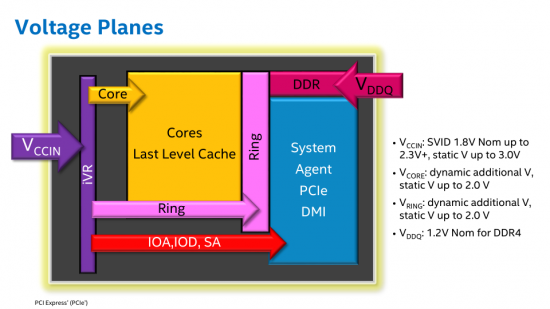
Besides overclocking via the frequency multiplier, you can increase the base clock rate. The LGA2011-v3 platform has a standard set of PCI Express and DMI frequency divisors that let you easily use a base clock rate of 100, 125, 166 and 250 MHz. Most Haswell-E CPUs will only work at the first three values, though. You can deviate from them, but the clock rate of the PCI Express and DMI buses becomes nonstandard in this case, which quickly renders your computer unstable. Stability is only ensured when the base clock rate is less than 5% off the core values of 100, 125 and 166 MHz.
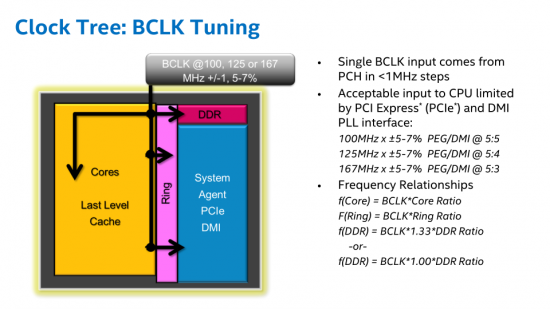
The memory controller integrated into the new processors allows overclocking DDR4 SDRAM in the same way as DDR3 could be overclocked on the earlier platforms. The memory frequency can be set with a step of 200 or 266 MHz. New memory modules support XMP 2.0 profiles which may contain settings that go beyond the JEDEC specs.
Talking about our practical tests, we first tried to overclock the flagship Core i7-5960X Extreme Edition. Frankly speaking, we didn’t expect it to overclock much because it had eight cores and a rather low standard clock rate. However, the low default voltage gave us some room for increasing it whereas the efficient internal thermal interface prevented overheat.
Using a liquid cooling system Corsair Hydro Series H110, we made our Core i7-5960X Extreme Edition stable at a clock rate of 4.2 GHz. We raised its voltage to 1.3 volts without overheat. During a stability check with LinX 0.6.5, the peak temperature was 96°C (the Haswell-E enables thermal throttling at 105°C).
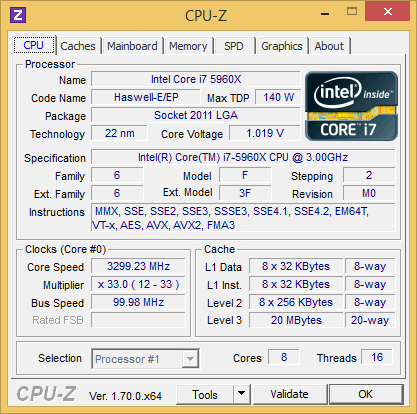
Although the resulting clock rate doesn’t look high, our speed gain is quite substantial. The 8-core Haswell-E turns out to be able to reach the same frequencies as the quad-core Haswell models for the LGA1150 platform. The default clock rate being 3.0 GHz, the frequency increase is as high as 40%. And we’re talking about a flagship CPU and sustainable overclocking (you can run the CPU at such settings for as long as you want without any problems). So if it were not for its steep price of $1000, the Core i7-5960X would be easily the most demanded CPU for enthusiasts.
As for the six-core Haswell-E models, their overclockability isn’t that impressive. Our Core i7-5930K couldn’t reach the clock rates of the earlier Ivy Bridge-E CPUs. It looks like Intel indeed makes these 6-core processors out of defective 8-core ones, which affects their overclocking potential. So our sample was stable at 4.2 GHz, just like its senior 8-core cousin. To ensure stability, we had to increase its voltage to 1.3 volts, and the CPU cores were as hot as 97°C when running LinX 0.6.5.

Thus, our Core i7-5930K could speed up by 20% above its default clock rate.
The lack of overclocking prowess of the new 6-core CPUs is confirmed by the results of the Core i7-5820K. Although it did better than its cousins, its performance was far from impressive. It reached 4.3 GHz, which was a mere 100 MHz higher than the peak clock rate of the flagship Core i7-5960X. Like with the other two models, we had to increase the voltage to 1.3 volts. The temperature was up to 95°C during a LinX 0.6.5 stability test.

It turns out that all Haswell-E processors, irrespective of the number of their x86 cores, have the same frequency potential: up to 4.2 or 4.3 GHz. Of course, we mean such overclocking that can be utilized on a 24/7 basis. Anyway, our Haswell-E processors do not overclock as smoothly as their Sandy Bridge-E and Ivy Bridge-E predecessors that could reach 4.5 GHz and higher. And this is not caused by a poor thermal interface or anything. It is the Haswell design itself that prevents better overclocking. Multi-core Haswell-based processors get much hotter than older CPUs as their clock rate gets higher.
It doesn’t mean that an overclocked Haswell-E is going to be slower than an overclocked Ivy Bridge-E, though. The more advanced microarchitecture and the sheer number of x86 cores should make the Core i7-5960X, Core i7-5930K and Core i7-5820K faster. You’ll see this in our performance tests where we’ll benchmark them at their default settings as well as in overclocked mode.
Testbed and Methods
It is reasonable to compare the new Haswell-E processors and the entire LGA2011-v3 platform with their predecessors: Ivy Bridge-E and LGA2011. That’s exactly what we’re going to do in our today’s tests. We do not include the quad-core i7-4820K, however, just because it is obviously inferior to the new 6- and 8-core models. Instead, we will test a configuration with a Core i7-4790K (Devil’s Canyon series) which also has only four cores but features a high clock rate (well above 4 GHz) to make up for that.
Considering that the Haswell-E series is offered for enthusiasts, the senior and junior models are going to be tested at their default clock rates as well as in overclocked mode (as described in the previous section of our review). To make the picture complete we’ll pit them against a flagship Ivy Bridge-E model (Core i7-4960X) overclocked to 4.5 GHz and a Devil’s Canyon processor working at the same clock rate.
Considering the market positioning of the LGA2011-v3 platform, we’ve introduced some changes into our graphics subsystem. It consists of two AMD Radeon 290X cards working in CrossFireX mode. This will help us get more interesting results in games where the graphics subsystem wouldn’t serve as a bottleneck anymore. Moreover, we’ll be able to see the benefits of senior Haswell-E models which allow building multi-GPU configurations with graphics slots working as PCIe x16/x16.
Below is the full list of hardware components we used in our testbed.
- Processors:
- Intel Core i7-5960X Extreme Edition (Haswell-E, 8 cores + HT, 3.0-3.5 GHz, 20MB L3 cache)
- Intel Core i7-5930K (Haswell-E, 6 cores + HT, 3.5-3.7 GHz, 15MB L3 cache)
- Intel Core i7-5820K (Haswell-E, 6 cores + HT, 3.3-3.6 GHz, 15MB L3 cache)
- Intel Core i7-4960X Extreme Edition (Ivy Bridge-E, 6 cores + HT, 3.6-4.0 GHz, 15MB L3 cache)
- Intel Core i7-4960K (Ivy Bridge-E, 6 cores + HT, 3.4-3.9 GHz, 15MB L3 cache)
- Intel Core i7-4790K (Haswell Refresh, 4 cores + HT, 4.0-4.4 GHz, 8MB L3 cache)
- CPU cooler: Liquid cooling system Corsair Hydro Series H110
- Mainboards:
- ASUS X99-Deluxe (LGA2011-v3, Intel X99)
- ASUS Z97-Pro (LGA1150, Intel Z97)
- Gigabyte X79-UP4 (LGA2011, Intel X79)
- System memory: 2x8GB G.Skill [TridentX] F3-2133C9D-16GTX DDR3-2133 SDRAM (9-11-11-31)
- 2x8GB G.Skill [TridentX] F3-2133C9D-16GTX DDR3-2133 SDRAM (9-11-11-31)
- 4x4GB G.Skill [TridentX] F3-2133C9Q-16GTX DDR3-2133 SDRAM (9-11-11-31)
- 4x4GB Corsair Vengeance LPX CMK16GX4M4A2666C16 DDR4-2666 SDRAM (15-17-17-35)
- Graphics cards: 2x AMD Radeon R9 290X (Hawaii XT, 4 GB/512-bit GDDR5, 1000/5000 MHz) in CrossFireX mode
- Storage: Intel SSD 520 240GB (SSDSC2CW240A3K5)
- Power supply: Corsair AX1200i (80 Plus Platinum, 1200 W)
We carry out our tests in Microsoft Windows 8.1 Professional x64 with the following drivers:
- AMD Catalyst Software Suite 14.9
- Intel Chipset Driver 10.0.17
- Intel Management Engine Driver 10.0.0.1204
- Intel Rapid Storage Technology 13.2.4.1000
As we’ve written above, some of the CPUs are tested twice: at their default clock rates and in overclocked mode.
- Intel Core i7-5960X Extreme Edition at a clock rate of 4.2 GHz and voltage of 1.3 volts
- Intel Core i7-5960K at a clock rate of 4.3 GHz and voltage of 1.3 volts
- Intel Core i7-4960X Extreme Edition at a clock rate of 4.5 GHz and voltage of 1.5 volts
- Intel Core i7-4790K at a clock rate of 4.5 GHz and voltage of 1.225 volts
Performance Tests
General performance
As usual, we use the Bapco SYSmark suite to estimate performance in everyday computing tasks. It emulates a user working in popular office and digital content creation and processing applications. The test produces a single score indicative of the computer’s average performance across different applications. SYSmark has been updated recently, so we use the latest version, SYSmark 2014, for our tests.
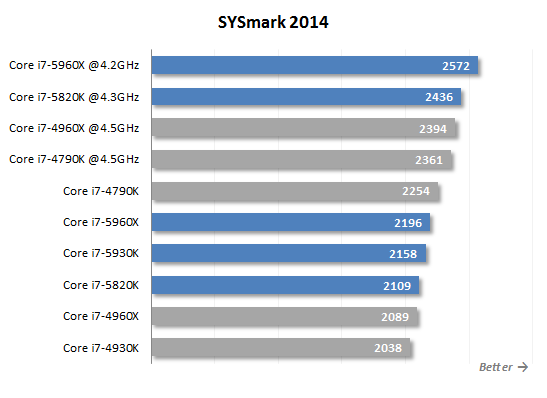
The Haswell-E processors have higher SYSmark 2014 scores than their Ivy Bridge-E predecessors largely due to improvements in their microarchitecture. It is less important that the Core i7-5960X has more x86 cores. As you can see, the quad-core Devil’s Canyon is ahead of the new 8-core flagship. It is clear that popular applications which are used in this benchmark prefer a higher clock rate to the number of execution cores. Indeed, the majority of everyday programs cannot run effectively on multicore CPUs.
Overclocking may help with the Core i7-5960X because it accelerates better than the rest of Intel’s flagship CPUs. When overclocked to 4.2 GHz, the 8-core Haswell-E beats the Core i7-4960X and Core i7-4790K (with six and four cores, respectively) which work at 4.5 GHz.
The 6-core Haswell-E models look good, too. Even the junior Core i7-5820K outperforms the ex-flagship i7-4960X, both at their default settings and in overclocked mode. The $400 6-core processor for the LGA2011-v3 platform seems to be a most attractive deal.
Now let’s take a closer look at the performance scores SYSmark 2014 generates in different usage scenarios. The Office Productivity scenario emulates typical office tasks, such as text editing, spreadsheets, email and web-surfing. This scenario uses the following applications: Adobe Acrobat XI Pro, Google Chrome 32, Microsoft Excel 2013, Microsoft OneNote 2013, Microsoft Outlook 2013, Microsoft PowerPoint 2013, Microsoft Word 2013, and WinZip Pro 17.5.
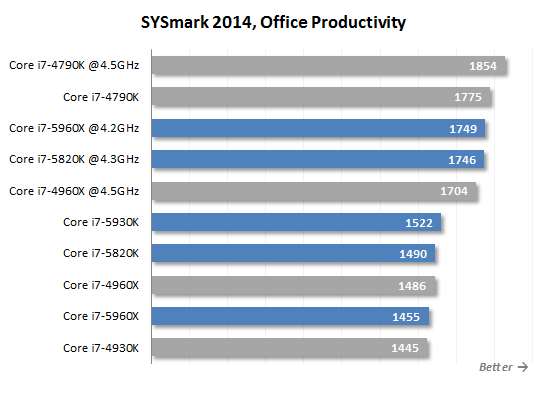
The Media Creation scenario emulates the creation of a video clip out of prepared materials (digital images and videos) using Adobe Photoshop CS6 Extended, Adobe Premiere Pro CS6 и Trimble SketchUp Pro 2013.
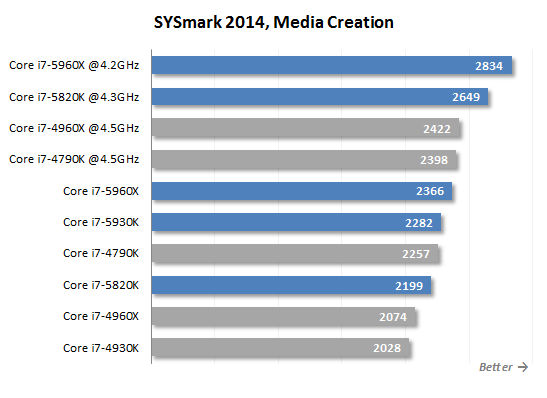
The Data/Financial Analysis scenario is devoted to statistical and market analysis. It processes a lot of numerical data in two applications: Microsoft Excel 2013 and WinZip Pro 17.5.
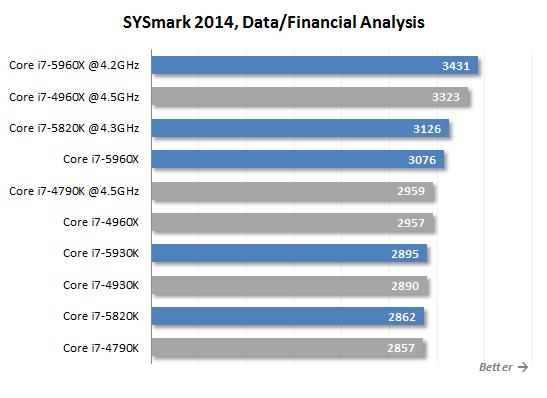
The individual scenarios highlight the benefits and downsides of the multicore CPU design. Typical office applications don’t call for processors like the Core i7-5960X. Such CPUs have a relatively low clock rate, so if the application cannot generate a heavy multi-threaded load, they turn out to be slower than simpler and cheaper alternatives which have fewer x86 cores but higher clock rates. Even overclocking doesn’t help: the Core i7-4790K for LGA1150 platforms delivers higher performance anyway.
Media content authoring and processing is quite a different story. The Haswell microarchitecture and the sheer number of x86 cores are both highly important for this kind of job. As a result, the Haswell-E models turn out to be much faster than their Ivy Bridge-E predecessors as well as the senior Devil’s Canyon which, by the way, is ahead of the Core i7-4960X thanks to having a more progressive microarchitecture.
Statistical analysis is a computing task that can be easily performed in parallel on multiple CPU cores. And the new 8-core i7-5960X has more than enough raw power to cope with that. The 6-core Haswell-E models are not that impressive, though. Working at lower clock rates, the Core i7-5930K falls behind the Core i7-4960X whereas the Core i7-5820K is inferior to the Core i7-4930K. On the other hand, the new CPUs are still better in terms of the price/performance ratio.
Gaming performance
s you know, it is the graphics subsystem that determines the performance of the entire platform in the majority of contemporary games if the platform has a fast enough processor. Therefore, we select the most CPU-dependent games and measure the frame rate in two test modes. For the first mode we use lower resolutions and disable full-screen antialiasing, so we could see how well the processor can cope with gaming loads in general. This provides some insight into how the tested CPU is going to behave in the nearest future when it is accompanied with faster graphics cards. The second test mode refers to real-life settings: Full HD and maximum FSAA. In our opinion, these results are no less interesting as they demonstrate clearly the level of performance we can expect from contemporary processors today.
For this test session we’ve built a very fast graphics subsystem by combining two AMD Radeon R9 290X cards into a CrossFireX tandem. That’s why some games are limited by the CPU even at the Full-HD resolution.
Full-HD with maximum visual quality settings:
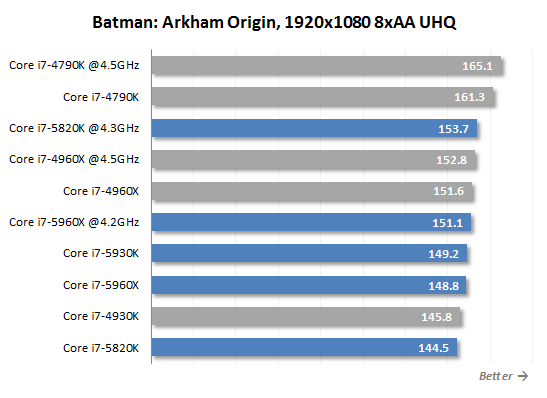
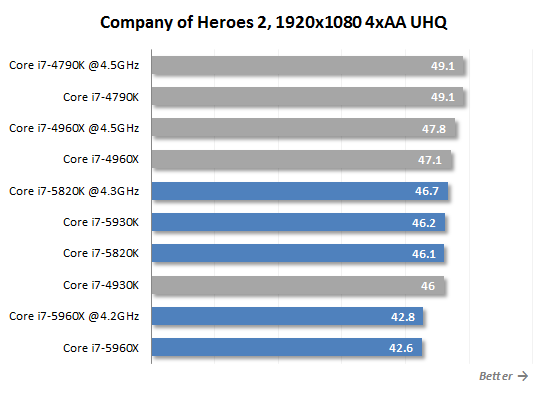
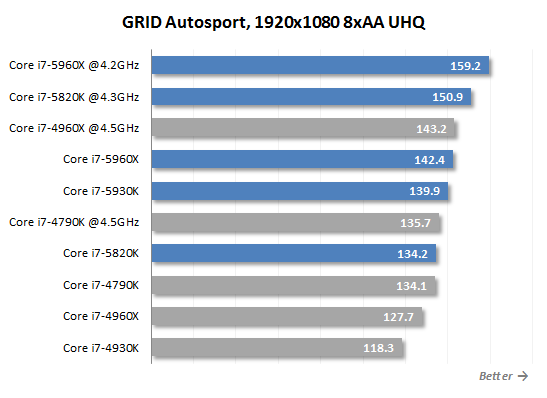
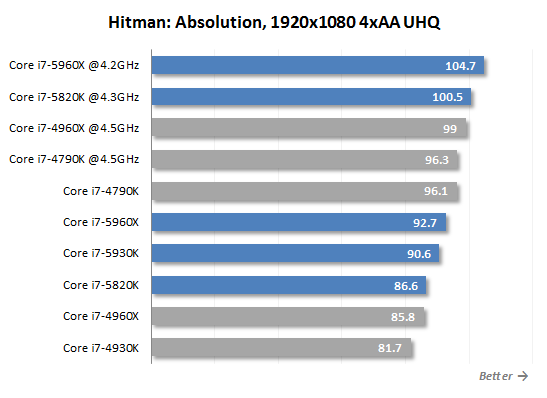
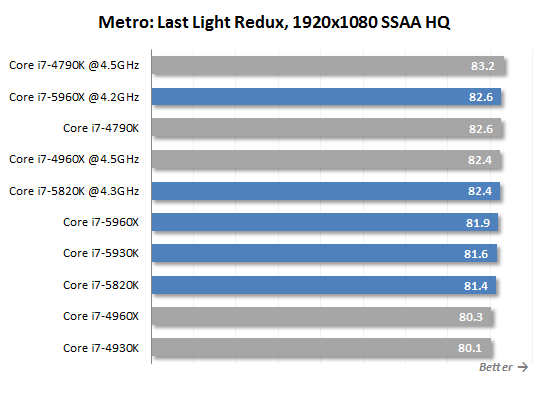
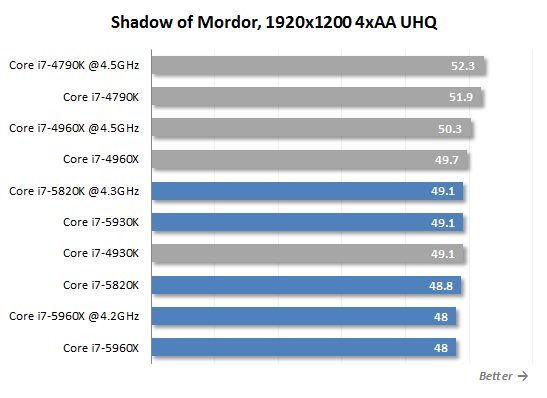
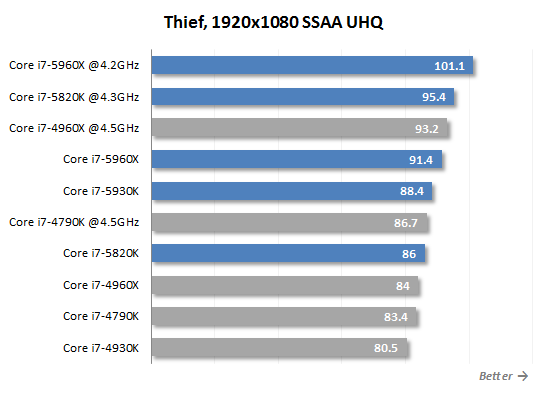
We’ve added a few more games to our standard list to see how beneficial multicore CPUs are for gaming configurations. The results are ambiguous, though. The Haswell-E series are better than the Devil’s Canyon in some games but worse in others. Frankly speaking, the 8-core Haswell-E isn’t the optimal choice for a gaming computer because today’s games have only started to be optimized for quad-core CPUs. Eight cores would be useless for them. In most games the quad-core Devil’s Canyon with a high clock rate beats the 8-core i7-5960X as well as the 6-core i7-5930K and i7-5820K. Neither the large L3 cache nor the quad-channel DDR4 SDRAM can save the day for the Haswell-E series. Thus, the LGA2011-v3 platform is too expensive and less efficient than its alternative when it comes to gaming.
We should remind you that we use two CrossFireX-linked graphics cards in our today’s tests and still can’t see any benefits from the Haswell-E series. For example, the LGA1150 platform has its PCIe 3.0 slots working at a speed of 8x/8x, yet it doesn’t prevent the Core i7-4790K from winning the gaming tests. That’s why the capability of the senior LGA2011-v3 CPUs to support 16x/16x graphics configurations is hardly an important advantage as it doesn’t provide tangible practical benefits. The Core i7-5820K with a cut-down PCIe controller is actually as good as the more expensive Core i7-5930K. You can use the former with multi-GPU graphics subsystems without losing anything in terms of speed, especially if you take its overclocking potential into account.
Lowered resolution results:
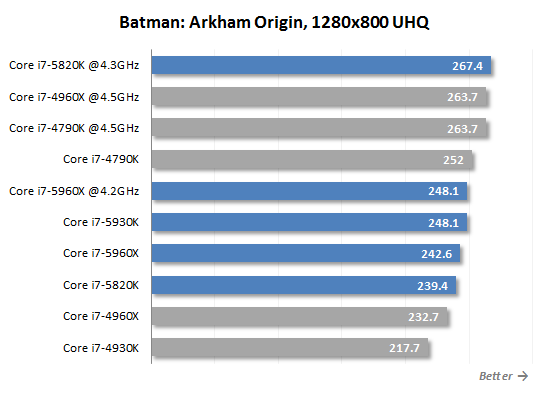
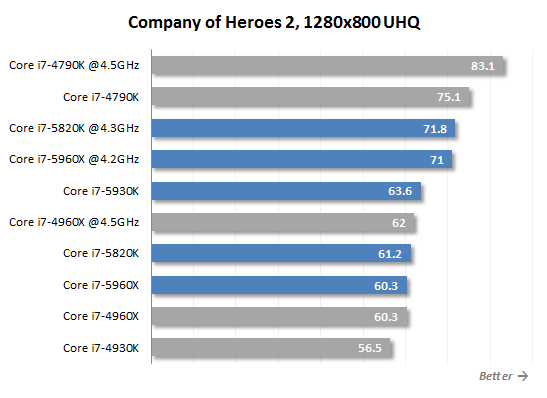
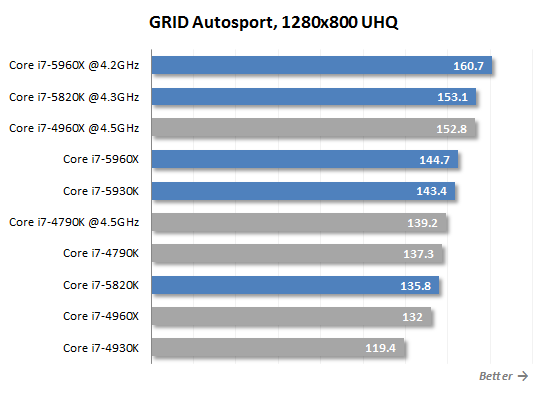
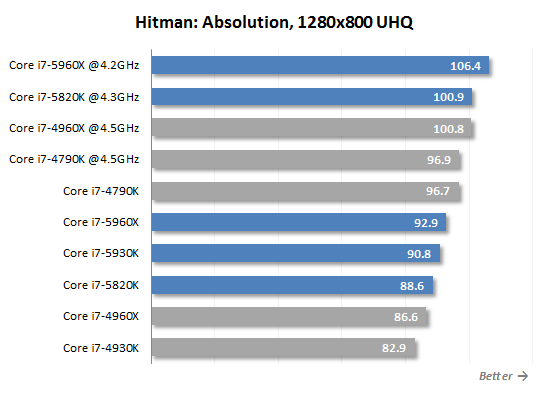
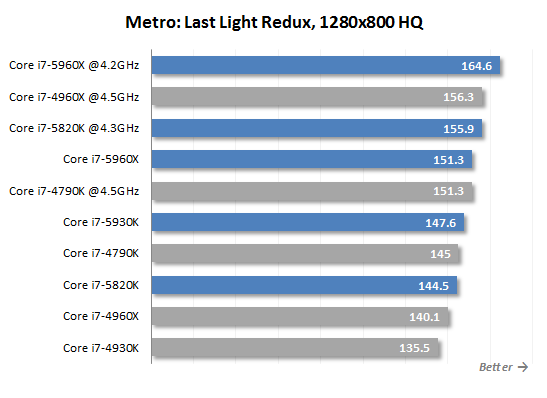
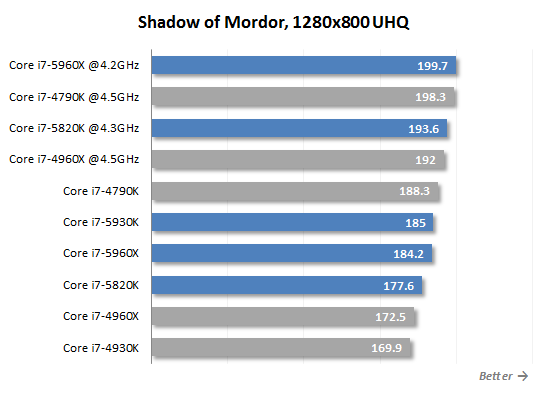
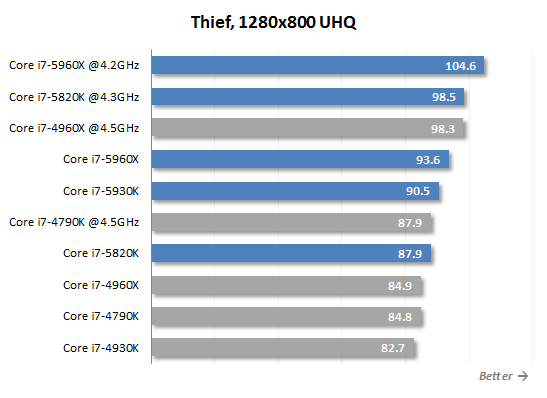
When the graphics subsystem doesn’t limit the processor’s speed, the Haswell-E series, including the 6-core models, do better. There are a number of games where the Core i7-5960X is ahead of the Core i7-4790K.
The Ivy Bridge-E series used to be installed in gaming computers and had no problems running video games. The newer Haswell-E generation is faster, both in 8- and 6-core versions, so they should be as good a choice, especially if you’re building a future-proof gaming configuration. Obviously, upcoming games will be able to make a more efficient use of multiple CPU cores.
Winding up the gaming part of our review, we will run Futuremark 3DMark.
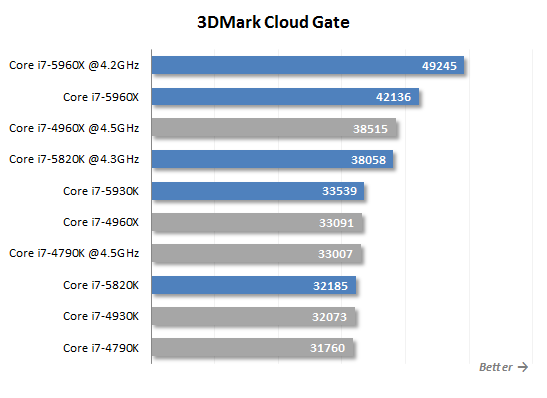
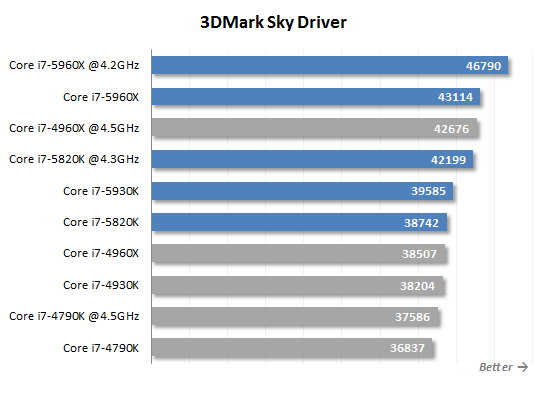
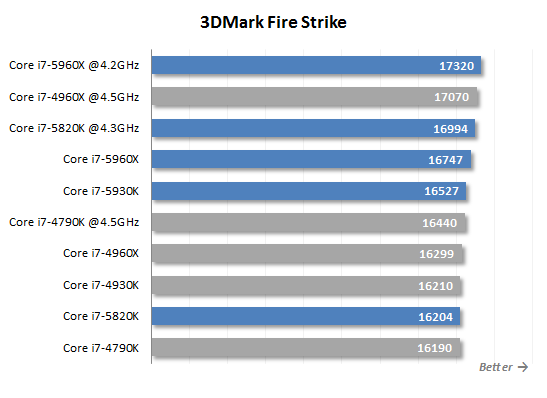
3DMark is well optimized for multicore CPUs, so the 8-core i7-5960X delivers very high performance, leaving its opponents far behind. The 6-core i7-5930K and i7-5820K are as good as the ex-flagship i7-4960X. The 4GHz quad-core Devil’s Canyon is only comparable in 3DMark with the junior 6-core i7-5820K which has a clock rate of only 3.3 GHz.
Application tests
In Autodesk 3ds max 2015 we benchmark the speed of mental ray rendering of a 1920×1080 still from the Space Flyby scene of the SPEC benchmarking suite.
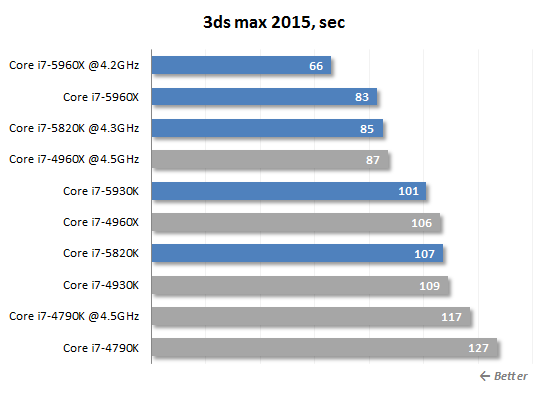
We benchmark performance in Adobe Photoshop CC 2014 using our custom test that is based on the Retouch Artists Photoshop Speed Test and consists of typical processing of four 24-megapixel images captured with a digital camera.
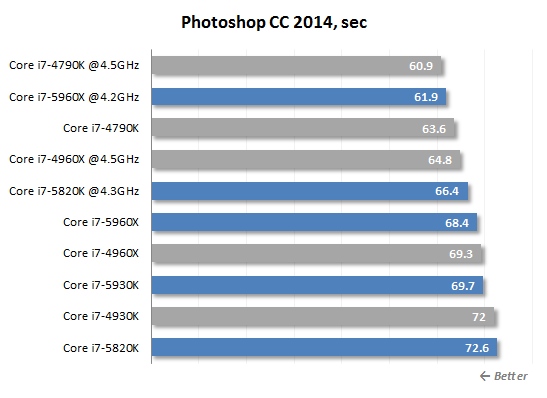
The test scenario for Adobe Photoshop Lightroom 5.6 is about post-processing of two hundred 12-megapixel RAW images captured with a Nikon D300 and exporting them into JPEG files (1920×1080 with maximum quality).
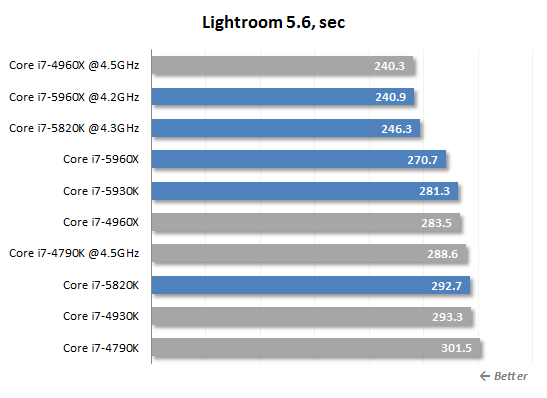
The performance in Adobe Premiere Pro CC 2014 is measured as the time it takes to render a Blu-ray H.264 project with HDV 1080p25 video and apply special effects to it.
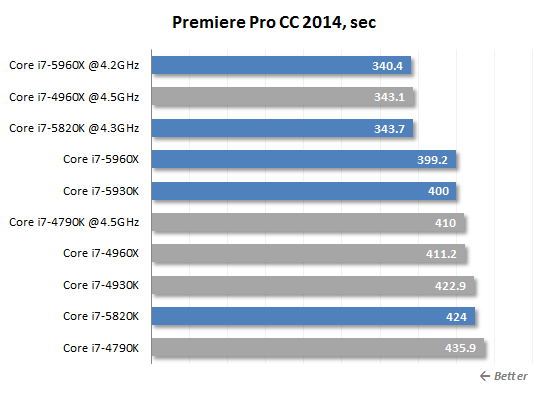
The processors’ performance in cryptographic tasks is measured with the built-in benchmark of the popular TrueCrypt utility that uses triple AES-Twofish-Serpent encryption. Besides optimizations for multi-core CPUs, it supports the AES instructions.
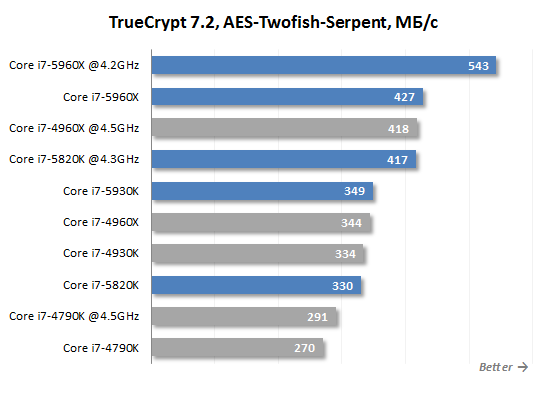
To test the processors’ performance at data archiving we launch WinRAR 5.0. Using maximum compression rate, we archive a 1.7GB folder with multiple files.
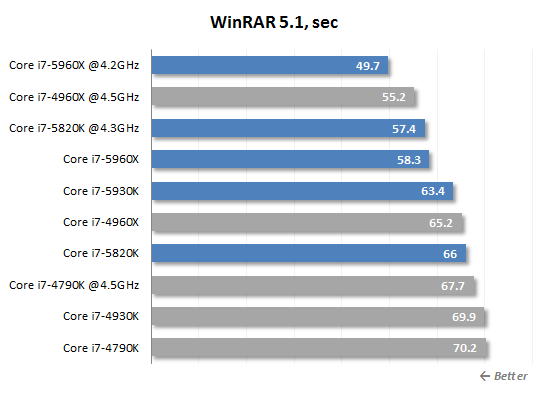
In order to measure how fast the tested CPUs can transcode video into H.264 format we used x264 FHD Benchmark 1.0.1 (64 bit). It measures the time it takes the x264 coder to convert an MPEG-4/AVC video recorded in 1920×1080@50fps resolution with default settings. The results have high practical value because the x264 codec is part of popular transcoding utilities such as HandBrake, MeGUI, VirtualDub, etc. We regularly update the coder used in this performance test. This time around, we use version r2453, which supports all contemporary instruction sets including AVX2.
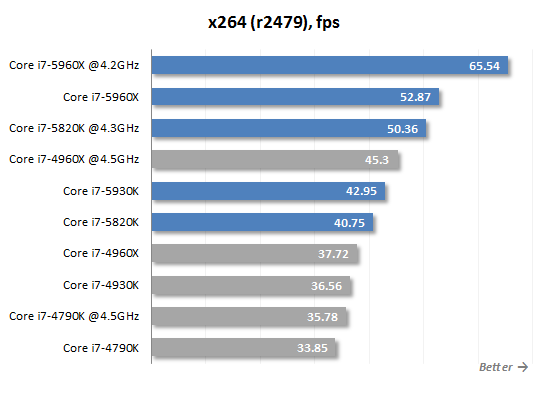
We’ve also added the new x265 coder to our list of tests. It is designed to transcode video into the H.265/HEVC format which improves on H.264 and features more efficient compression algorithms. We convert an original 1080p@50fps Y4M video file into the H.265 format using the medium profile. The coder is version 1.3.
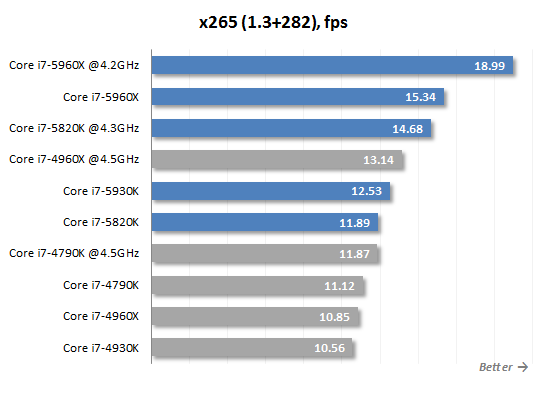
It is in resource-consuming applications for working with large amounts of data, images or video that we can see the true power of the new 8-core i7-5960X as it beats its predecessors by 20% to 40%. That’s the benefits we wanted to see with each recent CPU generation, yet the microarchitecture improvements could only ensure a performance increase of just a few percent. The new $1000 chip is different. It combines a new microarchitecture with additional x86 cores, which indeed produce an astounding effect in a number of heavy professional applications. The only problem is that the extra cores are not utilized by all programs, so you may wind up having no performance benefits at all.
Anyway, the Core i7-5960X seems to be worth the investment for people who use their desktop PCs as workstations. It is not only a good replacement for Ivy Bridge-E configurations but also faster than the senior LGA1150 processor of the Devil’s Canyon series.
The 6-core Haswell-E products offer high performance, too. The midrange Core i7-5930K model is comparable to the Core i7-4960X whereas the junior Core i7-5820K is as fast as the Core i7-4930K. Thus, the new 6-core CPUs are one step higher on the performance ladder compared to the year-old offers for the LGA2011 platform.
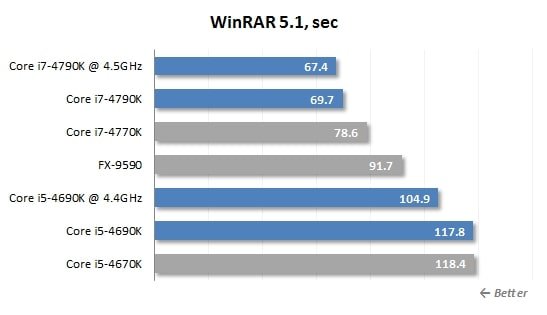
In order to measure how fast the tested CPUs can transcode video into H.264 format we used x264 FHD Benchmark 1.0.1 (64 bit). It measures the time it takes the x264 coder to convert an MPEG-4/AVC video recorded in 1920×1080@50fps resolution with default settings. The results have high practical value because the x264 codec is part of popular transcoding utilities such as HandBrake, MeGUI, VirtualDub, etc. We regularly update the coder used in this performance test. This time around, we use version r2453, which supports all contemporary instruction sets including AVX2.
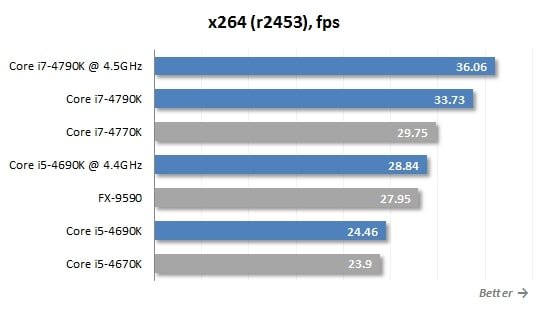
Power Consumption
Compared to their Ivy Bridge-E predecessors, the Haswell-E series feature a redesigned microarchitecture and more x86 cores (in the senior model), so it is quite surprising that their TDP hasn’t changed much. Of course, Intel had to reduce the clock rate of the 8-core i7-5960X Extreme Edition so that its power consumption wouldn’t be much higher compared to its 6-core predecessors. Anyway, we had some doubts that eight Haswell cores would be able to fit into the 140-watt TDP. We had to check this out in practice.
So, the graphs below show the full power draw of the computer (without the monitor) from the wall socket. It is the total power consumption of all system components. The PSU’s efficiency is taken into account but our Corsair AX1200i is a highly efficient 80 PLUS Platinum product, so its effect on the result is very small. We enable Turbo technology and all power-saving technologies: C1E, C6 and Enhanced Intel SpeedStep.
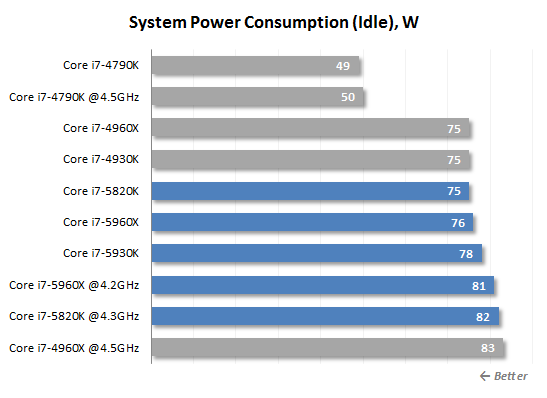
The new LGA2011-v3 platform doesn’t offer any power-related benefits in idle mode. It needs about as much power as the older LGA2011 and more than the mainstream LGA1150 platform. It is no wonder because the Haswell-E design and the X99 chipset feature sophisticated integrated controllers. Moreover, the new CPUs do not support the C7 power-saving state.
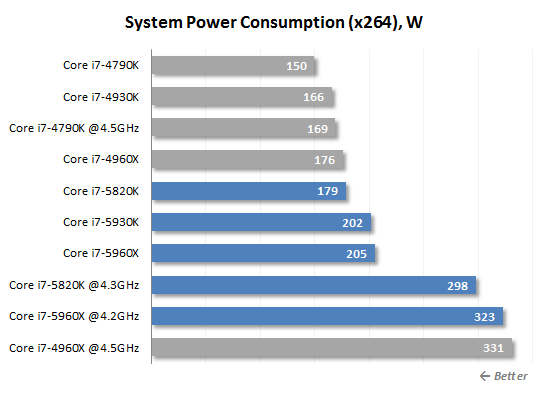
When transcoding video with the x264 coder, the Core i7-5960X and Core i7-5930K are comparable in their power requirements. The Core i7-5820K is somewhat more economical, but any of the Haswell-E models needs more power than the Core i7-4960X. The higher specified TDPs of the new CPUs indeed reflect their increased power consumption, so the entire LGA2011-v3 platform is not only faster but also less economical. And the difference may be as large as 30 watts at high loads.
Next we measure the peak power consumption when our configurations run the 64-bit version of the LinX 0.6.5 utility (based on the Linpack suite) with support for the AVX2 instruction set.
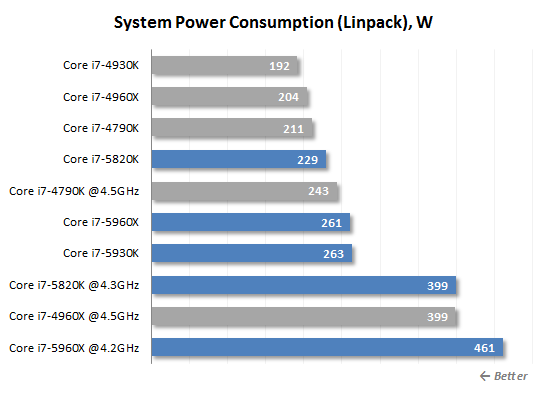
We’ve got the same standings as in the previous test except that each CPU needs more power when running LinX. The Haswell-E have higher power requirements than their predecessors, both the 8- and 6-core models. We should also note that even modest overclocking provokes a serious increase in the power draw of the Haswell-E CPUs – by up to 200 watts in our tests. So if you’re planning to overclock your LGA2011-v3 platform, you should pay special attention to choosing an appropriate PSU and cooling system.
Conclusion
Regardless of whether you like the new Haswell-E series or not, their announcement is a milestone for Intel’s enthusiast-targeted products. They introduce a number of important innovations including the first-ever desktop 8-core CPU, the up-to-date Haswell microarchitecture, the new DDR4 SDRAM, and the feature-rich X99 chipset. CPU developers have been far from innovative in terms of desktop products, so any of these improvements would deserve our interest. But Intel has packed them all into a single release, so the LGA2011-v3 platform makes a strong first impression.
But let’s try to be objective. The X99 chipset is indeed a big step forward in comparison with the downright outdated X79 but doesn’t differ much from the mainstream Z97. It doesn’t offer any fundamentally new features but has two downsides: a low-bandwidth chipset-CPU bus and lack of PCIe 3.0 support. Thus, the X99 seems to be a good upgrade but nothing more.
DDR4 SDRAM can hardly provoke our enthusiasm, too. Its benefits can only be felt with server applications where low power consumption and large amounts of system memory are indeed important. For high-performance desktop PCs, DDR4 doesn’t really offer much. Its clock rate isn’t higher compared to DDR3 while its high latencies make it even worse in terms of real-life performance. The biggest downside is that the Haswell-E is compatible with no other memory type and the high price of DDR4 SDRAM makes the whole LGA2011-v3 platform more expensive.
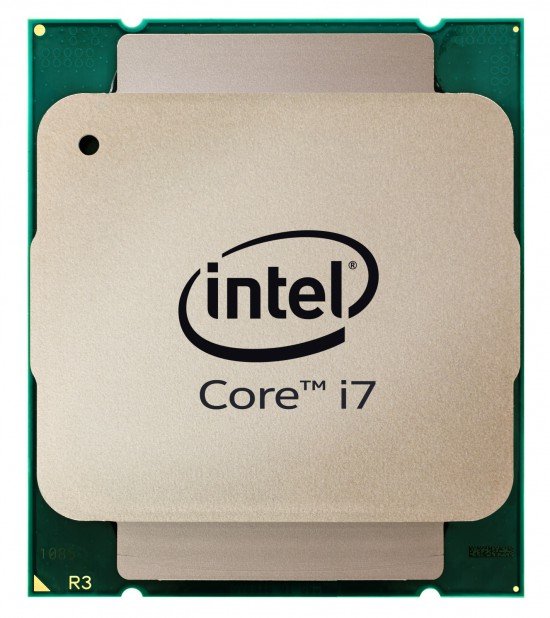
As for the Haswell-E series itself, we should talk about the 8-core i7-5960X Extreme Edition separately from its 6-core cousins i7-5820K and i7-5930K. The new 6-core models are an improvement over their Ivy Bridge-E predecessors. The $600 Core i7-5930K offers the same speed as the Core i7-4960X Extreme Edition whereas the $400 Core i7-5820K is comparable to the Core i7-4930K. Their advantage is only due to the Haswell microarchitecture because the 6-core Haswell-E have somewhat lower clock rates compared to the Ivy Bridge-E.
The Core i7-5960X Extreme Edition is quite a different story. Although working at a rather low clock rate, it is as good as its predecessor Core i7-4960X Extreme Edition even in applications which are not optimized for multithreading. And it becomes unrivalled in heavy applications capable of utilizing multiple CPU cores. The Core i7-5960X is the perfect choice for enthusiasts who are into creative work with audio, photo, video, heavy computations and 3D modeling.
The 8-core Haswell-E may not be the best choice for a gaming platform, though. We guess that Devil’s Canyon CPUs on the LGA1150 platform are more suitable for gaming even if you have a multi-GPU configuration (despite the fact that such a configuration cannot use the full bandwidth of the PCI Express bus on the LGA1150 platform).
The new Haswell-E series aren’t impressive in terms of overclocking. They are definitely worse than their predecessors in this respect, and the problem is about their microarchitecture rather than thermal interface or something. Ivy Bridge-E CPUs could be typically overclocked to 4.5 GHz and higher whereas the top frequency for the Haswell-E seems to be 4.2 or 4.2 GHz.
So, summing everything up, we should confess that the LGA2011-v3 platform isn’t something extraordinary despite the numerous innovations. Yes, it is better than anything Intel has produced so far in some aspects but it is not a breakthrough. It is just another step in the steady unhurried progress that has been going on with desktop PCs in the past few years. Upgrading to the Haswell-E may only be worthwhile if you want maximum computing performance, but the majority of desktop PC users don’t really need it. But if your case is exceptional, you should know that the Core i7-5960X Extreme Edition is undoubtedly the fastest desktop CPU today while the Core i7-5820K is the most optimal choice among the 6-core products. That’s our recommendations for all who are planning to transition to the LGA2011-v3 platform in the near future.